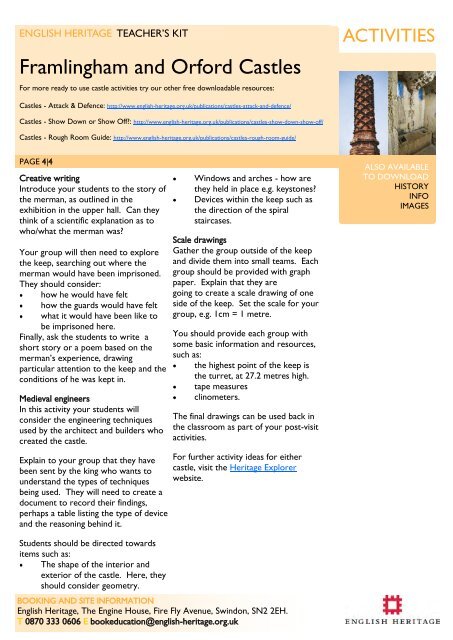HISTORY Framlingham and Orford Castles
HISTORY Framlingham and Orford Castles
HISTORY Framlingham and Orford Castles
You also want an ePaper? Increase the reach of your titles
YUMPU automatically turns print PDFs into web optimized ePapers that Google loves.
ENGLISH HERITAGE TEACHER’S KIT<br />
<strong>Framlingham</strong> <strong>and</strong> <strong>Orford</strong> <strong>Castles</strong><br />
For more ready to use castle activities try our other free downloadable resources:<br />
<strong>Castles</strong> - Attack & Defence: http://www.english-heritage.org.uk/publications/castles-attack-<strong>and</strong>-defence/<br />
<strong>Castles</strong> - Show Down or Show Off?: http://www.english-heritage.org.uk/publications/castles-show-down-show-off/<br />
<strong>Castles</strong> - Rough Room Guide: http://www.english-heritage.org.uk/publications/castles-rough-room-guide/<br />
PAGE 4|4<br />
Creative writing<br />
Introduce your students to the story of<br />
the merman, as outlined in the<br />
exhibition in the upper hall. Can they<br />
think of a scientific explanation as to<br />
who/what the merman was?<br />
Your group will then need to explore<br />
the keep, searching out where the<br />
merman would have been imprisoned.<br />
They should consider:<br />
how he would have felt<br />
how the guards would have felt<br />
what it would have been like to<br />
be imprisoned here.<br />
Finally, ask the students to write a<br />
short story or a poem based on the<br />
merman’s experience, drawing<br />
particular attention to the keep <strong>and</strong> the<br />
conditions of he was kept in.<br />
Medieval engineers<br />
In this activity your students will<br />
consider the engineering techniques<br />
used by the architect <strong>and</strong> builders who<br />
created the castle.<br />
Explain to your group that they have<br />
been sent by the king who wants to<br />
underst<strong>and</strong> the types of techniques<br />
being used. They will need to create a<br />
document to record their findings,<br />
perhaps a table listing the type of device<br />
<strong>and</strong> the reasoning behind it.<br />
Students should be directed towards<br />
items such as:<br />
The shape of the interior <strong>and</strong><br />
exterior of the castle. Here, they<br />
should consider geometry.<br />
Windows <strong>and</strong> arches - how are<br />
they held in place e.g. keystones?<br />
Devices within the keep such as<br />
the direction of the spiral<br />
staircases.<br />
Scale drawings<br />
Gather the group outside of the keep<br />
<strong>and</strong> divide them into small teams. Each<br />
group should be provided with graph<br />
paper. Explain that they are<br />
going to create a scale drawing of one<br />
side of the keep. Set the scale for your<br />
group, e.g. 1cm = 1 metre.<br />
You should provide each group with<br />
some basic information <strong>and</strong> resources,<br />
such as:<br />
the highest point of the keep is<br />
the turret, at 27.2 metres high.<br />
tape measures<br />
clinometers.<br />
The final drawings can be used back in<br />
the classroom as part of your post-visit<br />
activities.<br />
For further activity ideas for either<br />
castle, visit the Heritage Explorer<br />
website.<br />
BOOKING AND SITE INFORMATION<br />
English Heritage, The Engine House, Fire Fly Avenue, Swindon, SN2 2EH.<br />
T 0870 333 0606 E bookeducation@english-heritage.org.uk<br />
ACTIVITIES<br />
ALSO AVAILABLE<br />
TO DOWNLOAD<br />
<strong>HISTORY</strong><br />
INFO<br />
IMAGES


